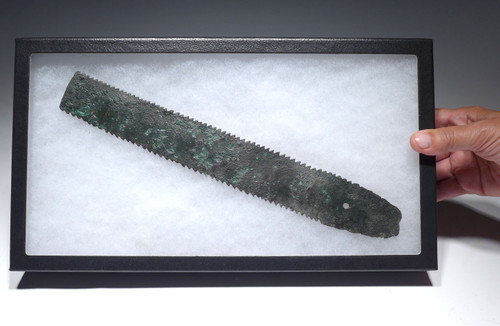Product Description
SEE MORE ANCIENT NEAR EASTERN LURISTAN ARTIFACTS
It may not be as impressive as a sword but this ancient medical surgical bone saw with integral handle is one of the RAREST objects we could offer from ANY Ancient culture! It comes from the Ancient Near East and is complete with heavy copper patina. Ancient saws are EXTREMELY scarce tools and their use in hand-held sizes such as this were used in ancient medical amputations which are scientifically documented (see references at end below). Medical care and injuries from combat often required amputation to save the patient. Amputations were also found to be a form of punishment in the ancient Near East, as well. In the last 24 years of our business, we have been fortunate enough to acquire only TWO specimens, one with an integral handle (this one), and one with a tang to embed in a handle, also currently for sale. This would make the ultimate gift for any physician, as well as a RARE addition to any ancient or antique medical tool collection!
The few specimens of any Bronze Age saws of all cultures that we have seen, are limited to blades that are tanged that would have fit into a separate handle. This example is much more luxurious with a beautiful cast integral handle with flared pommel. It would have been cast and then the blade hammered to its present thinness. The saw teeth would have been individually cut down the entire length of the working edge, as seen. Close-up images show this saw has been used EXTENSIVELY with worn and missing teeth. This is an example of the EARLIEST of ancient bronze saw designs based on the design of the teeth and cutting edge.
For the most advanced collections of museum displays, this is a "Holy Grail" ancient tool to acquire as the vast majority of museums in the world, lack these rare objects!
This artifact has been professionally cleaned and conserved in our lab, being treated with a special sealer developed and formulated by us specifically for ancient metal preservation. The patina shows beautiful traits only found in authentic ancient weapons. It is a patina like this that the finest ancient bronzes are prized for and it is a patina like this that brings a premium in price and value of the specimen. There is no active bronze disease. Bronze disease forms a corrosive powder that will literally eat away an artifact over time and destroy it.
WARNING: There is an increasing number of fake and altered composite Near Eastern (Luristan) bronze artifacts on the market. As fine quality intact, original specimens become more scarce and techniques have become more sophisticated to fake these weapons. We have personally handled numerous extremely well-done fakes with extremely convincing patinas. The degree to which the fakers have been able to replicate patina to disguise their work requires an expert examination by highly experienced individuals. It is common to find very reasonably priced weapons that are made up of part original and part modern components or wholly modern pieces displaying elaborate artificial patinas. All purchases should include from the dealer a written guarantee of authenticity with unconditional and lifetime return policies regarding such guarantee.
REFERENCES:
ANCIENT EGYPTIAN LIMB AMPUTATION
ANCIENT ORTHOPEDIC SURGERY AND AMPUTATION
 US DOLLAR
US DOLLAR
 EURO
EURO
 AUSTRALIAN DOLLAR
AUSTRALIAN DOLLAR
 CANADIAN DOLLAR
CANADIAN DOLLAR
 POUND STERLING
POUND STERLING




















